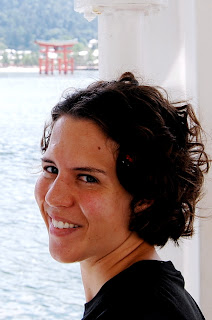
Watched stopped at 8:15 a.m. — the moment the atomic bomb exploded over Hiroshima.
Last week my sister-in-law Jenny and her friend came to visit us, so we took them around to all the big tourist sites. Of course they couldn't come to Hiroshima without visiting the Peace Memorial Museum, and though I've seen it before, I've never blogged about it, so I decided to go with them and shoot a few pictures.
The museum is a fascinating but depressing place filled with information about World War II history, the development and proliferation of nuclear weapons, and artifacts from the bomb's aftermath.
There are a few dioramas depicting the city before and after the bomb, including this one showing where the bomb exploded, decimating the entire landscape. Only a few skeletal buildings remained.
One of those was the Atomic Bomb Dome, almost directly beneath the blast, pictured here at center. At the time, it was a government building. Today it remains as a memorial to the bomb.
The bomb obliterated pretty much everything within a two-mile radius. Joe and I live about 4.7 miles from the hypocenter of the bomb (as the crow flies), far enough away that the buildings in our neighborhood wouldn't have been destroyed, though our area was hit with black rain. Actually, I'm not sure how developed our part of the city was at that time, since the museum stated that 90 percent of the city's buildings were destroyed or burned beyond repair.
To me, the most unforgettable parts of the museum are the second-floor exhibits illustrating the destruction. There are lots of pictures and stories about victims and their personal belongings — school children's tattered uniforms and things like that. Some of these things are truly heartwrenching to see. One of the more famous items is this:
A 3-year-old boy was riding this tricycle in front of his house when the bomb hit. He was badly burned and died that night. His father, feeling his son was too young to be buried in a lonely grave away from home, and thinking he could still play with the tricycle, buried his son with the tricycle in his backyard. Forty years later, he dug up the boy's remains to transfer them to the family grave, and donated the tricycle to the museum.
Perhaps the most stomach-turning exhibit confronts visitors as they round the corner into a new room. Inside an exhibit showing the aftermath of the bomb, we see wax figures of victims holding out their arms, skin melting off. This is a common image I've heard recounted many times by survivors of the bomb and in books. I remember one hibakusha (bomb survivor) explaining how she witnessed lines of burned victims shuffling down the street, holding out their arms like zombies, begging for water.
The bomb's fury sent shards of glass flying through the air with such force that they embedded in concrete.
The heat warped steel and melted glass.
One surprise I encountered in the museum when I went through last November with Diane and Paul was an actual mention of Springfield, Ohio, believe it or not. There is a section about a project started in September 2007 to display an atomic bomb exhibition in 101 U.S. cities, and one of them is Springfield. I imagine this was connected in some way to Wittenberg University since it has such a great East Asian Studies program.
There are all sorts of books out there if you are interested in learning more about the bombing. I'm not the type of person to read a pile of history books, but actually one of the books I can recommend for those interested in learning more about the bombing is a 10-volume graphic novel called Barefoot Gen: The Cartoon Story of Hiroshima. It was written by Keiji Nakazawa, a bomb survivor. I'm definitely no expert on writing book reviews, but I just wrote one for the Wide Island View. Actually it's not so much a review as just a piece urging people to check these books out. And you should — they're incredible.






